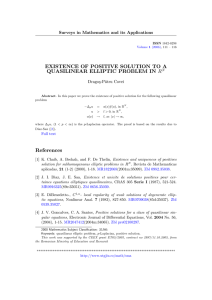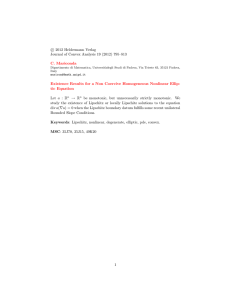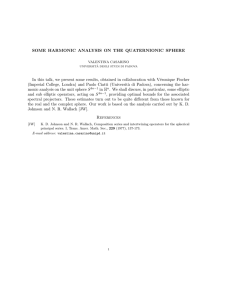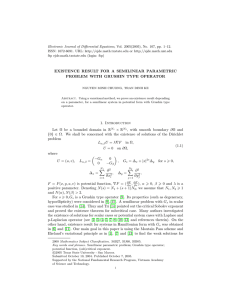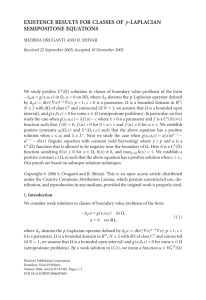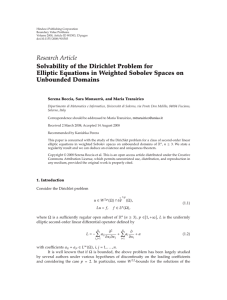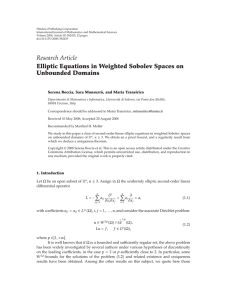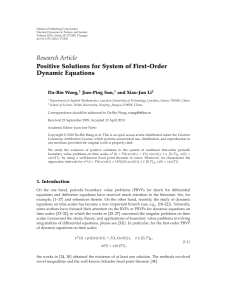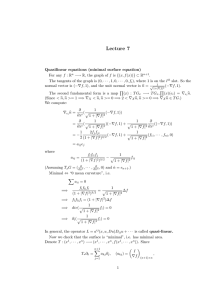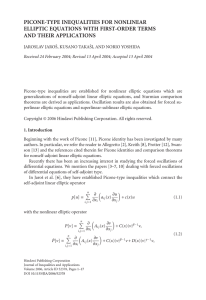Document 10841026
advertisement
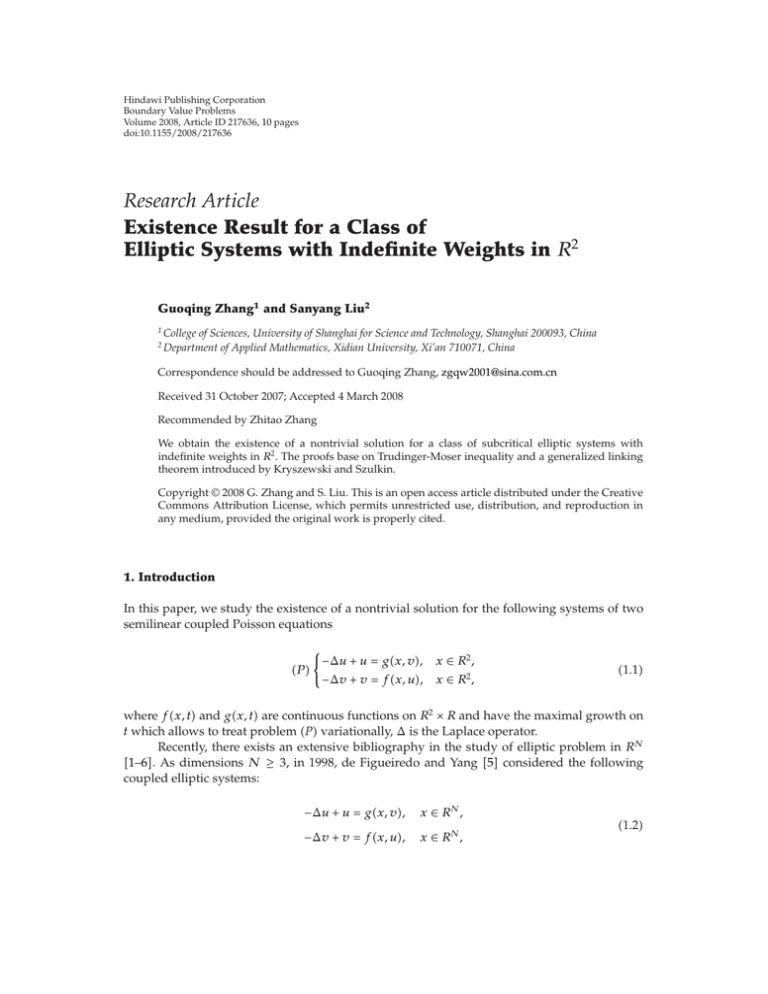
Hindawi Publishing Corporation
Boundary Value Problems
Volume 2008, Article ID 217636, 10 pages
doi:10.1155/2008/217636
Research Article
Existence Result for a Class of
Elliptic Systems with Indefinite Weights in R2
Guoqing Zhang1 and Sanyang Liu2
1
2
College of Sciences, University of Shanghai for Science and Technology, Shanghai 200093, China
Department of Applied Mathematics, Xidian University, Xi’an 710071, China
Correspondence should be addressed to Guoqing Zhang, zgqw2001@sina.com.cn
Received 31 October 2007; Accepted 4 March 2008
Recommended by Zhitao Zhang
We obtain the existence of a nontrivial solution for a class of subcritical elliptic systems with
indefinite weights in R2 . The proofs base on Trudinger-Moser inequality and a generalized linking
theorem introduced by Kryszewski and Szulkin.
Copyright q 2008 G. Zhang and S. Liu. This is an open access article distributed under the Creative
Commons Attribution License, which permits unrestricted use, distribution, and reproduction in
any medium, provided the original work is properly cited.
1. Introduction
In this paper, we study the existence of a nontrivial solution for the following systems of two
semilinear coupled Poisson equations
P −Δu u gx, v,
x ∈ R2 ,
−Δv v fx, u,
x ∈ R2 ,
1.1
where fx, t and gx, t are continuous functions on R2 × R and have the maximal growth on
t which allows to treat problem P variationally, Δ is the Laplace operator.
Recently, there exists an extensive bibliography in the study of elliptic problem in RN
1–6. As dimensions N ≥ 3, in 1998, de Figueiredo and Yang 5 considered the following
coupled elliptic systems:
−Δu u gx, v,
x ∈ RN ,
−Δv v fx, u,
x ∈ RN ,
1.2
2
Boundary Value Problems
where f, g are radially symmetric in x and satisfied the following Ambrosetti-Rabinowitz
condition:
t
fx, sds ≥ c|t|2δ1 ,
0
t
gx, sds ≥ c|t|2δ2 ,
∀t ∈ R,
1.3
0
and for some δ1 > 0, δ2 > 0. They obtained the decay, symmetry, and existence of solutions for
problem 1.2. In 2004, Li and Yang 6 proved that problem 1.2 possesses at least a positive
solution when the nonlinearities fx, t and gx, t are “asymptotically linear” at infinity and
“superlinear” at zero, that is,
1 limt→∞ fx, t/t l > 1, limt→∞ gx, t/t m > 1, uniformly in x ∈ RN ;
2 limt→0 fx, t/t limt→0 gx, t/t 0, uniformly with respect to x ∈ RN .
In 2006, Colin and Frigon 1 studied the following systems of coupled Poission
equations with critical growth in unbounded domains:
∗
−Δu |v|2 −2 v,
1.4
∗
−Δv |u|2 −2 u,
where 2∗ 2N/N − 2 is critical Sobolev exponent, u, v ∈ D01,2 Ω∗ and Ω∗ RN \ E with
E a∈ZN a ω∗ for a domain containing the origin ω∗ ⊂ ω∗ ⊂ B0, 1/2. Here, B0, 1/2
denotes the open ball centered at the origin of radius 1/2. The existence of a nontrivial solution
was obtained by using a generalized linking theorem.
As it is well known in dimensions N ≥ 3, the nonlinearities are required to have
polynomial growth at infinity, so that one can define associated functionals in Sobolev spaces.
Coming to dimension N 2, much faster growth is allowed for the nonlinearity. In fact, the
Trudinger-Moser estimates in N 2 replace the Sobolev embedding theorem used in N ≥ 3.
In dimension N 2, Adimurth and Yadava 7, de Figueiredo et al. 8 discussed the
solvability of problems of the type
−Δu fx, u,
u 0,
x ∈ Ω,
1.5
x ∈ ∂Ω,
where Ω is some bounded domain in R2 . Shen et al. 9 considered the following nonlinear
elliptic problems with critical potential:
Δu − μ u
2 fx, u,
|x| log R/|x|
u 0,
x∈Ω
1.6
x ∈ ∂Ω,
and obtained some existence results. In the whole space R2 , some authors considered the
following single semilinear elliptic equations:
−Δu V xu fx, u,
x ∈ R2 .
1.7
G. Zhang and S. Liu
3
As the potential V x and the nonlinearity fx, t are asymptotic to a constant function, Cao
10 obtained the existence of a nontrivial solution. As the potential V x and the nonlinearity
fx, t are asymptotically periodic at infinity, Alves et al. 11 proved the existence of at least
one positive weak solution.
Our aim in this paper is to establish the existence of a nontrivial solution for problem
P in subcritical case. To our knowledge, there are no results in the literature establishing
the existence of solutions to these problems in the whole space. However, it contains a basic
difficulty. Namely, the energy functional associated with problem P has strong indefinite
quadratic part, so there is not any more mountain pass structure but linking one. Therefore, the
proofs of our main results cannot rely on classical min-max results. Combining a generalized
linking theorem introduced by Kryszewski and Szulkin 12 and Trudinger-Moser inequality,
we prove an existence result for problem P.
The paper is organized as follows. In Section 2, we recall some results and state our main
results. In Section 3, main result is proved.
2. Preliminaries and main results
Consider the Hilbert space 13
H 1 R2 u ∈ L2 R2 , ∇u ∈ L2 R2 ,
2.1
and denote the product space Z H 1 R2 × H 1 R2 endowed with the inner product:
u, v, φ, ψ R2
∇u∇φ uφdx R2
∇v∇ψ vψdx,
∀φ, ψ ∈ Z.
2.2
If we define
Z {u, u ∈ Z},
Z − {v, −v ∈ Z}.
2.3
It is easy to check that Z Z ⊕ Z − , since
1
1
u, v u v, u v u − v, v − u.
2
2
2.4
Let us denote by P resp., Q the projection of Z on to Z resp., Z − , we have
2
2
1
1 u v, u v − 1 1 u − v, v − u
2 2
2 2
2
1
|∇u|2 |∇v|2 2∇u∇v dx |u| |v|2 2uv dx
2
2
4
R
R
2
2
2
2
−
|∇u| |∇v| − 2∇u∇v dx −
|u| |v| − 2uv dx
1 P u, v2 − Qu, v2 2
R2
R2
R2
∇u∇v uvdx.
2.5
4
Boundary Value Problems
Now, we define the functional
Iu, v 2
∇u∇v uvdx −
R
P u, v2
2
R
2
Qu, v2
−
2
Fx, u Gx, v dx
2.6
− ϕu, v,
∀u, v ∈ Z,
where
ϕu, v 2
Fx, u Gx, v dx.
2.7
R
Let z0 ∈ Z \ {0} and let R > r > 0, we define
M z z− λz0 : z− ∈ Z − , z ≤ R, λ ≥ 0 ,
M0 z z− λz0 : z− ∈ Z − , z R and λ ≥ 0 or z ≤ R and λ ≥ 0 ,
N z ∈ Z : z r .
2.8
Here, we assume the following condition:
H1 f, g ∈ CR2 × R, R;
H2 limt→0 fx, t/t limt→0 gx, t/t 0 uniformly with respect to x ∈ R2 ;
H3 there exist μ > 2 and η > 0 such that
0 < μFx, t ≤ tfx, t,
0 < μGx, t ≤ tgx, t,
∀|t| ≥ η.
2.9
Lemma 2.1 see 12, 14. Assume (H1), (H2), and (H3), and suppose
1 Iz 1/2P z2 −Qz2 −ϕz, where ϕ ∈ C1 Z, R is sequentially lower semicontinuous, bounded below, and ∇ϕ is weakly sequentially continuous;
2 there exist z0 ∈ Z \ {0}, α > 0, and R > r > 0, such that
inf Iz ≥ α > 0,
N
sup Iz ≤ 0.
2.10
M0
Then, there exist c > 0 and a sequence zn ⊂ Z such that
Izn −→ c,
I zn −→ 0,
as n −→ ∞.
2.11
Moreover, c ≥ α.
Theorem 2.2. Under the assumptions (H1), (H2), and (H3), if f and g has subcritical growth (see
definition below), problem (P) possesses a nontrivial weak solution.
G. Zhang and S. Liu
5
In the whole space R2 , do Ó and Souto 15 proved a version of Trudinger-Moser
inequality, that is,
i if u ∈ H 1 R2 , β > 0, we have
2
exp β|u|2 − 1 dx < ∞;
2.12
R
ii if 0 < β < 4π and |u|L2 R2 ≤ c, then there exists a constant c2 c1 c, β such that
sup
R2
|∇u|L2 R2 ≤1
exp β|u|2 − 1 dx < c2 .
2.13
Definition 2.3. We say fx, t has subcritical growth at ∞, if for all β > 0, there exists a positive
constant c3 such that
fx, t ≤ c3 exp βt2 ,
∀x, t ∈ R2 × 0, ∞.
2.14
3. Proof of Theorem 2.2
In this section, we will prove Theorem 2.2. under our assumptions and 2.14, there exist cε >
0, β > 0 such that
2
Fx, t, Gx, t ≤ t ε cε exp βt2 − 1 ,
2
∀ε > 0, ∀t ∈ R.
3.1
Then, we obtain
Fx, u, Gx, v ∈ L2 R2 ,
∀u, v ∈ H 1 R2 .
3.2
Therefore, the functional Iu, v is well defined. Furthermore, using standard arguments, we
obtain the functional Iu, v is C1 functional in Z and
I u, vφ, ψ R2
∇u∇ψ uψdx −
R2
R2
∇v∇φ vφ dx
fx, uφ gx, vψ dx,
3.3
∀φ, ψ ∈ Z.
Consequently, the weak solutions of problem P are exactly the critical points of Iu, v in Z.
Now, we prove that the functional Iu, v satisfied the geometry of Lemma 2.1.
Lemma 3.1. There exist r > 0 and α > 0 such that infN Iu, u ≥ α > 0.
Proof. By 2.14 and assumption H2, there exists cε > 0 such that
Fx, t, Gx, t ≤
t2
ε cε t3 exp βt2 − 1 ,
2
∀t ∈ R,
3.4
6
Boundary Value Problems
and thus on N, we have
Iu, u ≥
R
2
≥
≥
R2
R2
2
2
εu2 cε u3 exp βu2 − 1 dx
R
|∇u| u dx −
2
2
|∇u| u dx − ε
2
|∇u|2 u2 dx − ε
u dx − cε
2
R2
R2
u dx
u2 dx − cε u3
R2
R2
R2
1/2 6
exp
2
exp βu2 − 1 dx
2 βu − 1 dx
1/2
1/2
.
3.5
So, by the Sobolev embedding theorem and 2.12, we can choose r > 0 sufficiently small, such
that
Iu, u ≥ α > 0,
whenever u r.
3.6
Lemma 3.2. There exist u0 , u0 ∈ Z \ {0} and R > r > 0 such that supM0 I ≤ 0.
Proof. 1 By assumption H3, we have on Z −
Iu, u R2
|∇u|2 u2 dx −
R2
Fx, u Gx, −u dx ≤ 0
3.7
because Fx, t ≥ 0, Gx, t ≥ 0 for any x, t ∈ R2 × R.
2 Assumption H3 implies that there exist c4 > 0, c5 > 0 such that
Fx, t,
Gx, t ≥ c4 tμ − c5 ,
∀t ∈ R.
3.8
Now, we choose u0 , u0 ∈ Z \ {0} such that u0 , u0 r, then
I −v, v λ u0 , u0 λ2
R2
−
≤−
2
|∇u0 |2 u20 dx −
R2
|∇v|2 v2 dx
Fλu0 v G λu0 − v dx
3.9
R
R2
|∇u|2 u2 dx c λ2 − λμ .
Because μ > 2, it follows that for w ∈ M0
Iw −→ −∞,
whenever w −→ ∞,
and so, taking R > r large, we get supM0 I ≤ 0.
3.10
G. Zhang and S. Liu
7
Proof of Theorem 2.2. By Lemma 3.1, there exist r > 0 and α > 0 such that infN Iu, u ≥ α > 0. By
Lemma 3.2, there exist u0 , u0 ∈ Z \{0} and R > r > 0 such that supM0 I ≤ 0. Since Z Z ⊕Z − ,
we have
Iu, v ∇u∇v uvdx −
Fx, u Gx, v dx
R2
P u, v2
2
R2
−
Qu, v2
2
3.11
− ϕu, v,
∀u, v ∈ Z.
From 2.14, 3.1, and assumption H3, ϕu, v ∈ C1 , ϕu, v ≥ 0 and ϕu, v is sequentially
lower semicontinuous by Z ⊂ L2loc R2 × L2loc R2 and Fatou’s lemma; ∇ϕ is weakly sequentially
continuous. Thus, by Lemma 2.1 there exists a sequence un , vn ⊂ Z such that
Iun , vn −→ c ≥ α,
I un , vn −→ 0.
3.12
Claim 3.3. There is c < ∞, such that un , vn ≤ c for any n. Indeed, from 3.12, we obtain
that the sequence un , vn ⊂ Z satisfies
I un , vn c δn ,
I un , vn φ, ψ εn un , vn ,
as n −→ ∞,
3.13
where φ, ψ ∈ {un , vn }, δn → 0, εn → 0 as n → ∞. Taking φ, ψ {un , vn } in 3.13 and
assumption H3, we have
2
f x, un un g x, vn vn dx
R
≤2
2
≤
μ
F x, un G x, vn dx 2c 2δn εn un , vn R2
2
3.14
fx, un un g x, vn vn dx C 2δn εn un , vn ,
R
where C depends only on c and η in assumption H3. Since μ > 2, we have 1 − 2/μ > 0, and
thus
2
1−
f x, un un g x, vn vn dx ≤ C 2δn εn un , vn , ∀n ∈ N.
3.15
2
μ R
On the other hand, let φ, ψ vn , 0, φ, ψ 0, un in 3.13, we obtain
2
vn − εn vn ≤
2
f x, un vn dx,
2
un − εn un ≤
R
g x, vn un dx.
3.16
un
g x, vn dx εn .
un 3.17
R
2
that is,
vn ≤
vn
f x, un dx εn ,
vn 2
R
un ≤
2
R
8
Boundary Value Problems
Now, we recall the following inequality see 7, Lemma 2.4:
⎧ 2
1/2
n
1/4
⎪
⎨ e − 1 mlog m , n ≥ 0, m ≥ e ,
mn ≤ ⎪
⎩ e n2 − 1 1 m2 ,
n ≥ 0, 0 ≤ m ≤ e1/4 .
2
3.18
Let n vn /vn and m fx, un /c3 , where c3 is defined in 2.14, we have
f x, un vn
vn 2
exp
c3
− 1 dx
dx ≤ c3
c3
vn vn R2
R2
1/2
f x, un
f x, un
c3
dx
log
c3
c3
{x∈R2 ,fx,un /c3 ≥e1/4 }
2
f x, un
dx.
c3
c3
{x∈R2 ,fx,un /c3 ≤e1/4 }
By 2.12, we have
R2
3.19
exp vn /vn 2 − 1dx < ∞. By 2.14, we have
log
fx, t
c3
1/2
≤ β1/2 t.
3.20
Hence, we have
f x, un vn
1/2
dx ≤ c6 β
c3
f x, un un dx
2
2
c3
vn
R
R
3.21
for some positive constant c6 . So we have
vn ≤ c6 β1/2
2
f x, un un dx εn .
3.22
g x, vn vn dx εn
3.23
R
Using a similar argument, we obtain
un ≤ c7 β1/2
R2
for some positive constant c7 . Combining 3.22 and 3.23, we have
un , vn ≤ c8 1 δn εn un , vn εn
3.24
for some positive constant c8 , which implies that un , vn ≤ c. Thus, for a subsequence still
denoted by un , vn , there is u0 , v0 ∈ Z such that
un , vn −→ u0 , v0 weakly in Z, as n −→ ∞,
un , vn −→ u0 , v0 in Lsloc R2 × Lsloc R2 for s ≥ 1, as n −→ ∞,
un x, vn x −→ u0 x, v0 x , almost every, in R2 , as n −→ ∞.
3.25
G. Zhang and S. Liu
9
1
2
2
Then, there exists
hx ∈ 2H R such that |un x| ≤ h, ∀x ∈ R , ∀n ∈ N. From 2.12 and
2.14, we have R2 expβh x − 1dx < c, this implies
f x, un φdx −→
f x, u0 φdx, as n −→ ∞.
3.26
R2
Similarly, we can obtain
R
2
R2
g x, vn ψdx −→
2
g x, v0 ψdx,
as n −→ ∞.
3.27
R
From these, we have I un , vn φ, ψ 0, so u0 , v0 is weak solution of problem P.
Claim 3.4. u0 , v0 is nontrivial. By contradiction, since fx, t has subcritical growth, from
2.14 and Hölder inequality, we have
f x, un un dx ≤ c un exp βu2n − 1 dx
R2
R2
≤c
R2
q
|un | dx
1/q R2
exp
βqu2n
− 1 dx
where 1/q 1/q 1. Choosing suitable β and q, we have
exp βqu2n − 1 dx ≤ c.
R2
f x, un un dx ≤ c
R2
q
un dx
,
3.29
R2
Then, we obtain
3.28
1/q
1/q
.
3.30
Since un → 0 in Lq R2 , as n → ∞, this will lead to
f x, un un dx −→ 0,
R2
Similarly, we have
R2
g x, vn vn dx −→ 0,
Using assumption H3, we obtain
F x, un dx −→ 0,
R
2
2
as n −→ ∞.
3.31
as n −→ ∞.
3.32
G x, vn dx −→ 0,
This together with I un , vn un , vn → 0, we have
∇un ∇vn un vn dx −→ 0,
R2
Thus, we see that
as n −→ ∞.
3.33
R
I un , vn −→ 0,
as n −→ ∞.
as n −→ ∞.
3.34
3.35
which is a contradiction to Iun , vn → c ≥ α > 0, as n → ∞.
Consequently, we have a nontrivial critical point of the functional Iu, v and conclude
the proof of Theorem 2.2.
10
Boundary Value Problems
Acknowledgment
This work is supported by Innovation Program of Shanghai Municipal Education Commission
under Grant no. 08 YZ93.
References
1 F. Colin and M. Frigon, “Systems of coupled Poisson equations with critical growth in unbounded
domains,” Nonlinear Differential Equations and Applications, vol. 13, no. 3, pp. 369–384, 2006.
2 Y. Ding and S. Li, “Existence of entire solutions for some elliptic systems,” Bulletin of the Australian
Mathematical Society, vol. 50, no. 3, pp. 501–519, 1994.
3 D. G. de Figueiredo, “Nonlinear elliptic systems,” Anais da Academia Brasileira de Ciências, vol. 72, no. 4,
pp. 453–469, 2000.
4 D. G. de Figueiredo, J. M. do Ó, and B. Ruf, “Critical and subcritical elliptic systems in dimension
two,” Indiana University Mathematics Journal, vol. 53, no. 4, pp. 1037–1054, 2004.
5 D. G. de Figueiredo and J. Yang, “Decay, symmetry and existence of solutions of semilinear elliptic
systems,” Nonlinear Analysis: Theory, Methods & Applications, vol. 33, no. 3, pp. 211–234, 1998.
6 G. Li and J. Yang, “Asymptotically linear elliptic systems,” Communications in Partial Differential
Equations, vol. 29, no. 5-6, pp. 925–954, 2004.
7 Adimurthi and S. L. Yadava, “Multiplicity results for semilinear elliptic equations in a bounded
domain of R2 involving critical exponents,” Annali della Scuola Normale Superiore di Pisa, vol. 17, no. 4,
pp. 481–504, 1990.
8 D. G. de Figueiredo, O. H. Miyagaki, and B. Ruf, “Elliptic equations in R2 with nonlinearities in the
critical growth range,” Calculus of Variations and Partial Differential Equations, vol. 3, no. 2, pp. 139–153,
1995.
9 Y. Shen, Y. Yao, and Z. Chen, “On a class of nonlinear elliptic problem with critical potential in R2 ,”
Science in China Series A, vol. 34, pp. 610–624, 2004.
10 D. M. Cao, “Nontrivial solution of semilinear elliptic equation with critical exponent in R2 ,”
Communications in Partial Differential Equations, vol. 17, no. 3-4, pp. 407–435, 1992.
11 C. O. Alves, J. M. do Ó, and O. H. Miyagaki, “On nonlinear perturbations of a periodic elliptic problem
in R2 involving critical growth,” Nonlinear Analysis: Theory, Methods & Applications, vol. 56, no. 5, pp.
781–791, 2004.
12 W. Kryszewski and A. Szulkin, “Generalized linking theorem with an application to a semilinear
Schrödinger equation,” Advances in Differential Equations, vol. 3, no. 3, pp. 441–472, 1998.
13 M. Willem, Minimax Theorems, vol. 24 of Progress in Nonlinear Differential Equations and Their
Applications, Birkhäuser, Boston, Mass, USA, 1996.
14 G. Li and A. Szulkin, “An asymptotically periodic Schrödinger equation with indefinite linear part,”
Communications in Contemporary Mathematics, vol. 4, no. 4, pp. 763–776, 2002.
15 J. M. do Ó and M. A. S. Souto, “On a class of nonlinear Schrödinger equations in R2 involving critical
growth,” Journal of Differential Equations, vol. 174, no. 2, pp. 289–311, 2001.


